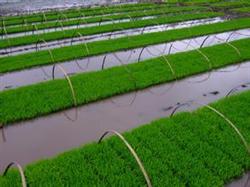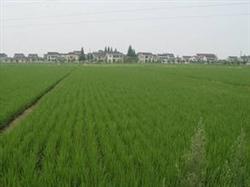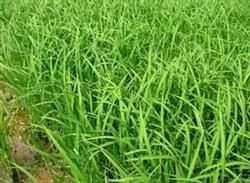Key techniques of mechanized transplanting and raising seedlings of rice

Rice mechanized transplanting is one of the most direct and efficient light and simple cultivation methods. in recent years, the technology of popularizing and using mechanized rice transplanting has been mature, and seedling raising technology is one of the key technologies of mechanical transplanting. The following technical measures are provided for reference. 1. The requirements of rice transplanter for seedlings the requirements of walking or high-speed seating transplanter are 58.0 cm × 28.0 cm × 2.0 cm × 2.5 cm (length × width × height), the four corners are vertical and square, and there is no lack of edges. There are 1 to 2 seedlings per square centimeter, the height of the seedlings is 10.0 to 20.0 cm, the seedlings are neat and uniform, the roots are knotted, and can be put into the seedling box as a whole. two。 The common seedling raising methods developed in recent years are hard disk seedling raising, soft disk seedling raising, double film seedling raising and other seedling raising methods. The cost of raising seedlings with hard disk is high, so it is suitable to raise seedlings with floppy disk and double film. No matter which kind of seedling raising method, dry seedling raising and wet seedling raising can be adopted. Dry seedling raising is easy to control seedling height, developed root system, good knotting, large elasticity of seedling age and short slow seedling period after planting, which is more conducive to high yield. 3. The determination of sowing date should take into account stubble, seedling age, variety and local climatic conditions. The seedling age of mechanically transplanting seedlings matched with wheat stubble is generally less than 25 days. Therefore, the sowing date of winter fallow field and early stubble field was the same as that of local hand transplanting, and it was planted in advance in the suitable planting period. On the other hand, the wheat (oil) stubble field should be sown by 25 days according to the previous harvest time. 4. The determination of sowing rate is mainly determined by the requirements of mechanical seedling grasping and seedling quality. in the case of seedling grasping, the lower the sowing rate per unit area is, the higher the seedling quality is. According to the calculation of 1 to 2 seedlings per square centimeter, with an average of 1.5 seedlings, each seedling tray (58 cm × 28 cm) needs to sow 80 × 90 grams, and the lower the 1000-grain weight, the smaller the sowing rate. 5. Key points of dry transplanting and raising seedlings by machine (1) fine seedling bed. The fields with flat terrain, leeward to the sun, convenient water source, deep soil layer, loose fertile soil, convenient transporting seedlings and convenient operation and management were selected as seedling board fields, and the seedling fields were prepared according to the seedling field and Honda 1 ∶ 80m 100. Turn (rotate) the seedling field before sowing, flatten and fine. Then open the ditch to do the seedling bed, the seedling bed is 1.40 meters wide, the ditch is 0.40 meters wide, and the ditch depth is 0.15 meters. It is required that the surface of the box is flat and the bottom water is permeated. (2) prepare nutritious soil. Nurturing seedlings in the field requires 750 kg of nutrient soil per hectare (for about 240 million 270 seedling trays). Take fertile vegetable garden soil or loose paddy soil in advance and pour it into human and animal feces and urine, add 2 kg of calcium superphosphate to 100 kg, then air-dry and break it. Soil is mixed with seedling strengthening agent before sowing, but attention should be paid to the type and dosage of seedling strengthening agent, and it must be tested first. It is recommended to use seedling strengthening agent suitable for local soil characteristics instead of inorganic fertilizer and to mix 0.5-0.8 kg dry seedling strengthening agent per 100 kg fine soil after bed soil processing. (3) Seedling tray discharge. For floppy disk seedling raising, two rows of floppy disk are arranged horizontally, the flying edge of the disk and the flying edge of the disk overlap and intersect, and the bottom of the plate is close to the bed surface to ensure that the seedling plate is not deformed and not warped. (4) pave the subsoil. Spread the subsoil on the seedling plate with a thickness of 1.8 cm to 2.0 cm (about 2.5 kg of nutritious soil). After laying, scrape it flat with wood strips, and the thickness should be uniform. After laying the soil, wet the subsoil with a sprinkler. (5) uniform sowing. The method of soaking in the day and dew at night was used to make the rice seeds white. When sowing, the seeds should be weighed according to the seedling plate, so as to achieve uniform sowing and sub-sowing. (6) covering soil. Cover the seeds with the prepared nutritious soil without seedling strengthening agent, and it is appropriate to cover the seeds with no seed thickness. There should be no mud on the frame, in case it is not conducive to raising seedlings because of the string of roots. (7) Seedling management. The core of the management within one week after sowing is the regulation and control of moisture, and it is necessary to keep the seedling bed wet and dry. The criteria to be mastered are: the topsoil of the seedling bed should not be watered without whitening, measures should be taken to atomize or refine the water droplets, and no heavy water droplets should be irrigated fiercely; each watering should not form stagnant water on and around the plate, and always keep the soil moist in the valley. It is emphasized that in this period, neither the dry soil can be cracked, nor can there be stagnant water on the bottom of the plate, so that the water and gas can be coordinated to form strong buds and strong seedlings. (8) raising seedlings and transplanting. Raising seedlings with floppy disk can be rolled up and transplanted. When transplanting, the times of moving the seedling block should be reduced as much as possible, so as to ensure that the seedling will not be deformed, broken or hurt.
- Prev

New technique of Rice Seedling raising with perforated Film
How to control field seedling pests, root rot and rice seedbed diseases in spring? on March 25, the Municipal Agricultural Technology extension Station answered common questions for farmers during spring ploughing. Disasters should be prevented by doing a good job in seed chemical treatment, controlling seedling diseases and insect pests, and vigorously popularizing seedling cultivation in large and medium-sized greenhouses. It is understood that in 2009, I.
- Next

Dry Seedling raising technique of Rice
According to the investigation in recent years, it is found that most of the rice seedlings are raised in the rice Honda. Honda has poor permeability and cold pulp under perennial flooding conditions, which is not conducive to the cultivation of strong seedlings. Raising seedlings in dry land is to cultivate rice seedlings under the condition of dry land. Oxygen is sufficient in the soil of dry land, and water, gas and fertilizer are easy to coordinate.
Related
- The first cup of black tea in spring, the flavor and history of tea gardens in Kenya, Africa
- The computer can not only choose potatoes, but also grow tea rice. AI will grow winter oolong tea champion.
- It is not only the inflated tea bitten by insects, but also engraved with the four seasons tea in Beipu.
- The Oriental Beauty Tea Festival in Zhuxian County takes the stage at the weekend to experience the plus-size feast of oil tea.
- & quot; Oriental Beauty Tea & Exploration of Emei in Hsinchu, the hometown of quot;
- The new variety of strawberry "Tainong 1" dessert is the first choice with mellow aroma. Crimson gorgeous
- History of Tea in Taiwan: from Wild Inner Mountain to Export Tea Garden
- Two types of Taiwan Oriental Beauty Black Tea won the British three-Star Award for Childhood Tea Xiang Zhang Jiaqi changed from pilot to champion tea maker.
- Banana species and varieties: the planting history of Taiwan Xianren banana and dwarf banana is long, is banana disease resistant?
- Coffee planting Technology: Qianjie Coffee from Seedling to harvesting

